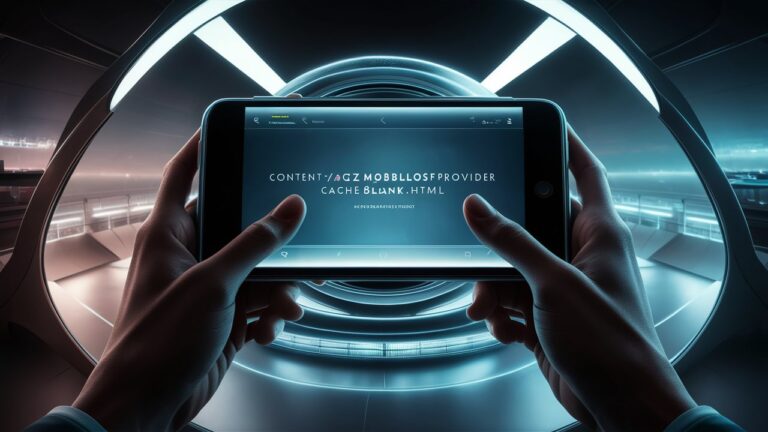Introduction
Android users sometimes come across technical strings like content://cz.mobilesoft.appblock.fileprovider/cache/blank.html when using productivity apps such as AppBlock. At first glance, this can look confusing or even alarming, leading people to wonder if their device is malfunctioning, if the file is malicious, or if it’s part of the normal system. In reality, this URI is part of Android’s content provider system, specifically tied to AppBlock’s FileProvider function, which handles temporary files and cached data. By understanding what it means, why it appears, and how to manage it, users can feel reassured that it’s not harmful but simply a technical component of app functionality.
What Is content://cz.mobilesoft.appblock.fileprovider/cache/blank.html?
This string is a content URI. On Android, apps don’t access files directly for security reasons. Instead, they use content providers to share and manage data. The part cz.mobilesoft.appblock identifies the developer’s package name (MobileSoft’s AppBlock app), while fileprovider/cache/blank.html points to a temporary file in the app’s cache.
Essentially, when you see blank.html, it usually means the app requested a placeholder or temporary file, often for displaying restricted or blocked web content. Since AppBlock specializes in limiting distractions, it may redirect or replace certain web pages with a “blank” placeholder to block you from opening them.
Why Does This File Appear?
There are a few reasons users may encounter this URI:
-
AppBlock Blocking Mechanism – When the app blocks a website, it may use
blank.htmlas a placeholder instead of loading the actual page. -
Cached File Storage – Temporary files are stored in the
/cache/folder, and this URI is simply Android’s way of referencing them. -
Debugging or Error Messages – Sometimes users see this URI if something goes wrong while loading a page, and instead of the intended output, the placeholder path is displayed.
In all cases, this file itself is harmless—it doesn’t store personal data, malware, or executable content.
Is content://cz.mobilesoft.appblock.fileprovider/cache/blank.html Safe?
Yes, this URI is completely safe. It is not a virus, spyware, or anything malicious. It is a normal byproduct of how Android manages files through content:// URIs. Unlike suspicious third-party domains or downloads, this string points to an internal file within the AppBlock app’s sandbox environment, meaning it cannot access other apps or expose your data.
If you are concerned, clearing the AppBlock cache in your phone settings can remove the temporary file. However, it will simply be recreated the next time AppBlock needs to block a page, so there is no ongoing risk.
How to Fix Issues Related to content://cz.mobilesoft.appblock.fileprovider/cache/blank.html
For most users, there’s nothing to “fix” since this URI is expected behavior. However, if it’s causing inconvenience (e.g., appearing frequently or disrupting browsing), here are a few steps you can try:
-
Clear AppBlock Cache: Go to Settings > Apps > AppBlock > Storage > Clear Cache.
-
Update the App: Make sure you’re running the latest version of AppBlock from the Google Play Store.
-
Reinstall AppBlock: If issues persist, uninstall and reinstall the app to refresh its file structure.
-
Disable Blocking Temporarily: If the placeholder interrupts your workflow, you can pause or adjust blocking rules.
Why AppBlock Uses Blank Pages
The use of a blank.html file is intentional. Instead of redirecting users to potentially unsafe or distracting websites, AppBlock substitutes a harmless placeholder page. This design protects the user from falling back into distractions while keeping the browsing experience smooth. It’s a clever but simple solution for enforcing focus.
Conclusion
The content://cz.mobilesoft.appblock.fileprovider/cache/blank.html string may look complicated, but it’s actually a harmless part of how the AppBlock app manages temporary files through Android’s content provider system. Its role is primarily linked to blocking and redirecting unwanted pages, which aligns with AppBlock’s purpose as a productivity tool. Rather than being a problem or a security threat, this file is a technical placeholder that ensures the app functions correctly. For users seeking peace of mind, it’s safe to ignore, though clearing cache or updating the app can resolve any small glitches. Ultimately, this URI is a sign that AppBlock is working behind the scenes to keep distractions at bay.
❓ FAQ (Frequently Asked Questions)
Q1: What does content://cz.mobilesoft.appblock.fileprovider/cache/blank.html mean?
It’s an Android content URI generated by the AppBlock app. It points to a placeholder HTML file in the cache, often used when blocking websites.
Q2: Is this URI a virus or malware?
No. It is safe. It’s simply an internal file managed by AppBlock and cannot harm your device.
Q3: Why does AppBlock use a blank.html file?
AppBlock replaces blocked pages with a blank placeholder instead of loading the original site, helping enforce focus and productivity.
Q4: How can I remove it from my device?
You can clear AppBlock’s cache or reinstall the app, but the file may reappear as it’s part of normal functioning.
Q5: Do I need to worry about my personal data?
No. The file only resides in AppBlock’s cache and does not store or transmit your personal information.
